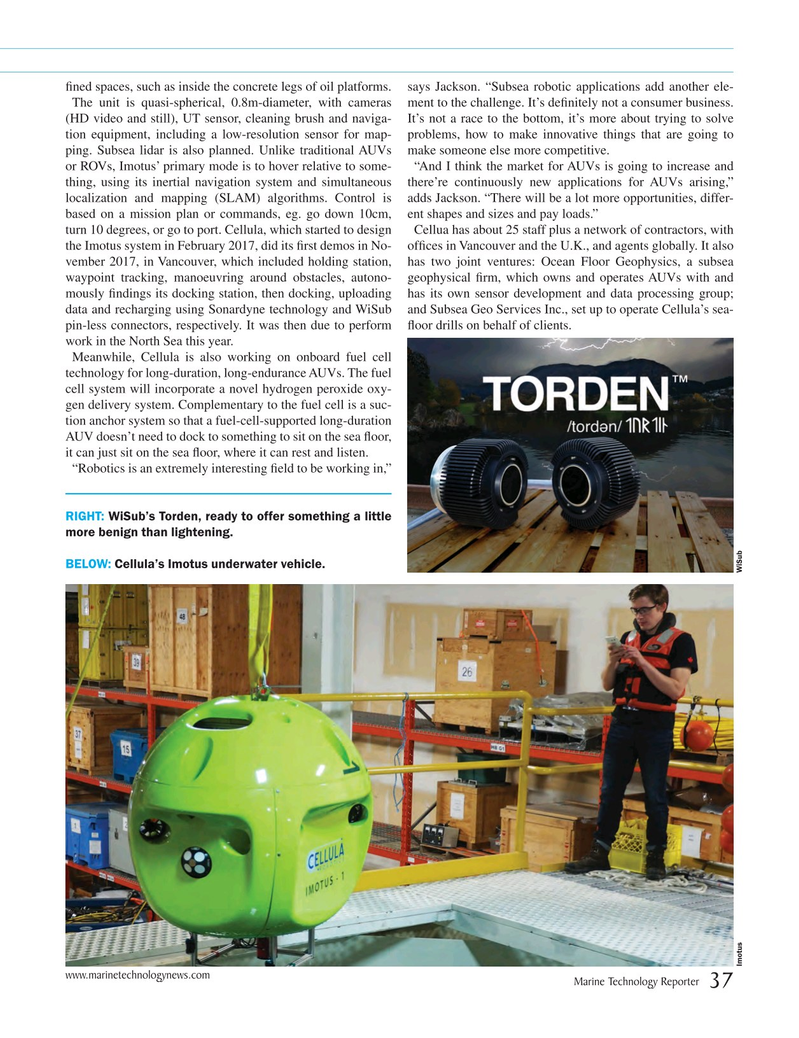
Page 37: of Marine Technology Magazine (July 2018)
MTR100: Listing of 100 Leading Subsea Companies
Read this page in Pdf, Flash or Html5 edition of July 2018 Marine Technology Magazine
? ned spaces, such as inside the concrete legs of oil platforms. says Jackson. “Subsea robotic applications add another ele-
The unit is quasi-spherical, 0.8m-diameter, with cameras ment to the challenge. It’s de? nitely not a consumer business. (HD video and still), UT sensor, cleaning brush and naviga- It’s not a race to the bottom, it’s more about trying to solve tion equipment, including a low-resolution sensor for map- problems, how to make innovative things that are going to ping. Subsea lidar is also planned. Unlike traditional AUVs make someone else more competitive.
or ROVs, Imotus’ primary mode is to hover relative to some- “And I think the market for AUVs is going to increase and thing, using its inertial navigation system and simultaneous there’re continuously new applications for AUVs arising,” localization and mapping (SLAM) algorithms. Control is adds Jackson. “There will be a lot more opportunities, differ- based on a mission plan or commands, eg. go down 10cm, ent shapes and sizes and pay loads.” turn 10 degrees, or go to port. Cellula, which started to design Cellua has about 25 staff plus a network of contractors, with the Imotus system in February 2017, did its ? rst demos in No- of? ces in Vancouver and the U.K., and agents globally. It also vember 2017, in Vancouver, which included holding station, has two joint ventures: Ocean Floor Geophysics, a subsea waypoint tracking, manoeuvring around obstacles, autono- geophysical ? rm, which owns and operates AUVs with and mously ? ndings its docking station, then docking, uploading has its own sensor development and data processing group; data and recharging using Sonardyne technology and WiSub and Subsea Geo Services Inc., set up to operate Cellula’s sea- pin-less connectors, respectively. It was then due to perform ? oor drills on behalf of clients.
work in the North Sea this year.
Meanwhile, Cellula is also working on onboard fuel cell technology for long-duration, long-endurance AUVs. The fuel cell system will incorporate a novel hydrogen peroxide oxy- gen delivery system. Complementary to the fuel cell is a suc- tion anchor system so that a fuel-cell-supported long-duration
AUV doesn’t need to dock to something to sit on the sea ? oor, it can just sit on the sea ? oor, where it can rest and listen. “Robotics is an extremely interesting ? eld to be working in,”
RIGHT: WiSub’s Torden, ready to offer something a little more benign than lightening.
BELOW: Cellula’s Imotus underwater vehicle.
Imotus WiSub www.marinetechnologynews.com
Marine Technology Reporter 37
MTR #6 (34-49).indd 37 MTR #6 (34-49).indd 37 8/10/2018 2:06:24 PM8/10/2018 2:06:24 PM

 36
36

 38
38
